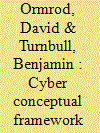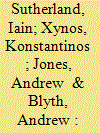| Srl | Item |
| 1 |
ID:
145859


|
|
|
|
|
| Summary/Abstract |
Militaries rely on secure communications. Despite the permeation of cyber-systems throughout the operational environment, there is little readily available doctrine on cyber-warfare. Doctrine that does exist has not been coherently integrated. This paper introduces a Cyber Conceptual Framework, consisting of five questions pertinent to the future use of cyberspace. The authors enunciate a definition of cyberspace, expand on existing military doctrine to reject the conceptualisation of cyberspace as a domain, define cyber-conflict, define cyber-attack and describe the four components and five levels of a cyber-attack. This work develops a common framework from available doctrine and a lexicon for future discussion.
|
|
|
|
|
|
|
|
|
|
|
|
|
|
|
|
| 2 |
ID:
140948


|
|
|
|
|
| Summary/Abstract |
Considerable scholarly effort has been invested in interpreting the existing international legal instruments and diplomatic conventions that apply to kinetic warfare in relation to the field of cyber-warfare. The Tallinn Manual and other documents argue that current humanitarian laws are applicable in cyber-conflict. This includes the concept that particular religious and medical entities should be granted special, protected status along with sites of cultural and religious significance and those containing ‘dangerous forces’. In a kinetic-warfare environment, these sites and non-combatants are identifiable by the use of international symbols such as the Red Cross, Red Crystal and Red Crescent emblems, or other specific signs. Here, Sutherland, Xynos, Jones and Blyth suggest that a simple digital marker could ensure that systems and traffic can be identified as protected in cyber-conflict under the Geneva Conventions.
|
|
|
|
|
|
|
|
|
|
|
|
|
|
|
|